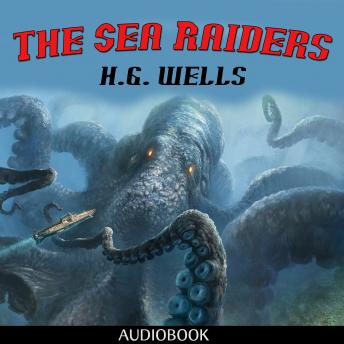“The Sea Raiders” is a short story by the English author H. G. Wells (1866–1946), first published in the 6 December 1896 edition of the Weekly Sun Literary Supplement and subsequently reprinted in The Plattner Story and OthersCollection of 17 short stories by H. G. Wells, first published in 1897. (1897) and The Country of the Blind and Other StoriesCollection of 33 short stories by H. G. Wells, first published in 1911. (1911).[a]The story’s title was originally
hyphenated as “The Sea-Raiders”.[1] The story tells of a raid by an unknown species of octopus-like creatures on the south coast of England.[2]
Synopsis
The unidentified narrator tells of a tea-dealer called Fison who is holidaying in Devon. While out walking along the cliff top, he sees on the rocky beach below him what at first looks like a flock of birds fighting over some kind of pinkish-coloured food. His curiosity piqued, Fison climbs down to the beach and discovers that it is actually the corpse of a partially devoured human being, surrounded by octopus-like bodies that are feeding on it.
Fison’s is the first sighting of a hitherto unknown species of deep-sea creature that in the story is given the name Haploteuthis ferox, meaning “singular ferocious squid”.[1] At first he believes the creatures to be harmless, but when they notice his presence they chase him to the foot of the cliffs, and he barely manages to escape their long tentacles. He returns to the area in a boat, with the boatman, Hill, and two local workmen who had helped to save him by pelting the creatures with rocks. The creatures below them in the shallow water attack the boat, and there is a prolonged struggle during which Fison glances up and sees a larger boat about fifty yards away, on which are three women and a child, seemingly unaware of the danger they are in; Fison tries to warn them.
Then suddenly Hill’s arm becomes covered with tentacles: “the eyes of one of the brutes that had hold of him, glaring straight and resolute, showed momentarily above the surface”, and he is pulled under the water. The incoming tide carries the boat onto the rocky shore; Fison and the two workmen jump from the boat in terror and make their way to the beach. Fison realises he is no longer being pursued, and then remembers that there was another boat. “He looked back again, and there were now two boats floating, and the one farthest out at sea pitched clumsily, bottom upward.” Hill and the ten occupants of the larger vessel have disappeared.
The narrator informs us that “hunger migration” has been suggested to explain the creatures’ sudden appearance, but speculates that it may be more likely that a shoal of them, after a foundering ship happened to sink among them, took a liking to human flesh and followed Atlantic traffic to the English coast.
Commentary
The plot of “The Sea Raiders” is essentially an elaboration on the theme of an essay titled “The Extinction of Man” – “one of Wells’s early exercises in pessimism” – published in The Pall Mall GazetteEvening newspaper launched in London in 1865, which introduced investigative journalism into British journalism, along with other innovations. on 25 September 1894.[3]
See also
- H. G. Wells bibliographyList of publications written by H. G. Wells during the more than fifty years of his literary career.
Notes
| a | The story’s title was originally hyphenated as “The Sea-Raiders”.[1] |
|---|
References
Bibliography
External links
- Full text of “The Sea Raiders” at Project Gutenberg

